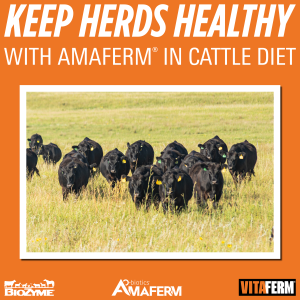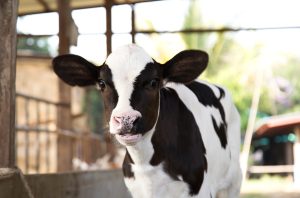
There are always challenges that accompany the calving season – dystocia, weak calves and winter storms. Wouldn’t it be nice if you could calve for one year with no stress and worries about the newborn calf or its mama?
One challenge producers don’t often think about is mastitis in cattle. Mastitis is an inflammatory condition of the mammary gland that affects cattle, causing economic losses and health concerns in the herd. While mastitis is more commonly associated with dairy cattle, mastitis in beef cattle can also be a significant issue. It results in decreased milk production, poor calf growth and increased culling rates.
At BioZyme®, makers of VitaFerm® cattle vitamin and mineral supplements, we want to ensure your herd stays healthy, and that includes reducing incidences of mastitis in cattle. Herd health starts with good nutrition and management practices. However, before you can keep your herd healthy, you must know what to protect against.
Let’s explore mastitis in cattle from the signs, prevention and treatment protocols.
Signs of Mastitis in Cattle
Mastitis typically presents visible symptoms that make it easy to diagnose. It is most prevalent in cows that have just calved and are in early lactation; however, it can appear during any time. Some visible signs of mastitis in cattle include:
- Swelling, redness and heat in the affected udder quarter
- Hardness or abnormal firmness of the udder
- Pain upon palpation, leading to discomfort in the cow
- Discolored, bloody or foul-smelling milk
- Presence of clots or flakes in the milk
- Decreased milk production
- Systemic signs such as fever, lethargy and reduced appetite in severe cases
- The cow might kick at the udder since it causes her pain OR she might kick at the calf since nursing causes more pain.
Causes of Mastitis in Cattle
Mastitis can result from several infectious or environmental factors. It is imperative to keep your herd healthy and calving area as clean as possible to keep mastitis at bay. The most common causes of mastitis in cattle include:
Bacterial Infections
Bacteria are the primary cause of mastitis. The most common bacterial pathogens include:
- Staphylococcus aureus – A major cause of chronic mastitis, leading to abscess formation and fibrosis. It is highly contagious and can be passed from cow to cow, if you are treating one animal and move to another without properly washing or disinfecting your hands.
- Escherichia coli – Often associated with environmental mastitis, leading to severe inflammation and systemic illness. Commonly referred to as E. coli, this is one of the common bacteria found in the calving area.
- Streptococcus uberis and Streptococcus agalactiae – Common in unhygienic conditions and capable of spreading between animals.
- Mycoplasma – Can cause severe, contagious mastitis.
Environmental Factors
Environmental conditions play a substantial role in mastitis development. Contributing factors include:
- Dirty bedding and contaminated water sources
- Poorly maintained calving areas with excessive mud and manure
- Exposure to wet and cold conditions, increasing stress on cattle
- Overcrowding, which leads to the spread of pathogens
Udder & Teat Injuries
Physical damage to the udder can cause unwanted infection to the cows. Common causes of udder and teat injury include:
- Trauma from suckling calves with unusually sharp teeth
- Scratches and abrasions from rough terrain or sharp objects
- Biting or aggressive behavior from other cows in the group
Poor Nutrition & Immune Suppression
A cow’s overall health and immunity influence vulnerability to mastitis. Leading factors include:
- Deficiencies in vitamins A, D and E, as well as selenium and zinc
- Poor body condition score, cattle with low BCS are more likely to have weakened immune defenses
- Stressors such as extreme weather, transport or calving difficulties
Prevention of Mastitis in Cattle
Preventing mastitis involves a combination of management, hygiene and herd health protocols. We always encourage prevention whenever feasible, as it is typically less expensive than treatment and keeps your herd overall healthier. Here are 5 best practices to prevent mastitis in cattle.
1. Proper Udder Hygiene
- Ensure cows have access to clean, dry bedding to minimize bacterial exposure.
- Maintain calving areas in sanitary conditions.
- Disinfect teats when handling cows, especially when assisting nursing.
2. Effective Calf Management
- Ensure calves receive sufficient colostrum within the first few hours after birth to strengthen immunity.
- Manage cross-suckling behavior, as aggressive nursing can cause udder injuries.
3. Nutrition & Immune Support
- Provide a balanced diet with adequate vitamins and minerals to your herd. Remember that protein for cattle is an important part of their lactation diet. This is where our nutritional program can help. VitaFerm® is a line of nutritional supplements for beef cattle that maximize energy and forage utilization for successful production.
- Ensure cows maintain a proper body condition score (BCS) to support immune function.
- Minimize stress by providing shelter, shade and protection from extreme weather.
4. Make Culling Decisions
- Identify and cull cows with recurring mastitis infections to prevent herd-wide transmission. Remember that most bacterial infections are highly contagious, and it is not worth keeping a cow that will spread those infections within the herd.
- Evaluating udders on cows that you might ultimately keep replacement daughters out of is also a good practice. If you have a cow family that always makes a low-hanging, saggy udder, it might not be the best decision to continue keeping females in that family. Weigh the benefits to the disadvantages. If those cows wean off exceptional, high-growth calves that generate revenue without mastitis issues, it is probably feasible to have a few ugly udders in the herd.
5. Vaccination Programs
- Some vaccines are available to reduce the severity of mastitis caused by specific pathogens such as E. coli and Staphylococcus aureus.
- Work with a veterinarian to develop an appropriate vaccination plan.
Treatment of Mastitis in Cattle
Timely and appropriate treatment is essential to reduce the impact of mastitis. Treatment strategies depend on the severity and cause of the infection. First and foremost, always consult with your veterinarian before implementing a treatment plan. Your veterinarian will be most knowledgeable about your herd, the local climate and be able to coordinate the best treatment plan with you.
Intramammary Antibiotics
- Antibiotic therapy is the primary treatment for bacterial mastitis.
- Use intramammary infusions for localized infections, ensuring compliance with withdrawal periods for meat safety, which would only be an issue if sending the cow to harvest.
- Commonly used antibiotics include penicillin, cephalosporins and macrolides.
Systemic Antibiotics & Anti-Inflammatories
- Severe cases may require systemic antibiotic injections.
- Nonsteroidal anti-inflammatory drugs (NSAIDs) such as flunixin meglumine, commonly known as Banamine®, can help reduce pain and inflammation.
Supportive Therapy
- Provide fluids and electrolytes for dehydrated cows.
- In cases of severe systemic illness, veterinary intervention may include intravenous therapy.
How Can VitaFerm Help?
Remember, we mentioned that we offer a nutritional supplement for cattle? Well, it seems like a long shot that a vitamin and mineral supplement could help prevent mastitis in cows. However, by boosting their natural immunity and keeping them in a good body condition score, you are increasing their overall well-being.
VitaFerm offers a supplement ideal for your cows, no matter what size or shape their udder is in. AO-Biotics® Amaferm® is the key additive in all VitaFerm products. It has nearly 200 published and/or presented research studies proving its increase in digestibility and, ultimately, its impact on the animal. Not only will you be supplementing your cows’ vitamin and mineral needs, but you will be providing them with Amaferm.
The key point of Amaferm is using it as a tool to get more energy metabolized by the cow. More forage digestibility leads to less physical fill so she can eat more. More VFA production provides the extra energy needed for thermoregulation, which will also help keep her warm in the cold winter months.
“Amaferm can help unlock the nutritional value of all types of forages. Amaferm goes beyond stimulating the growth of beneficial rumen bacteria and can also promote rumen fungal growth and enzymatic activity. This increases fiber digestibility and volatile fatty acid (VFA) production by 17% and 16%, respectively. As such, more energy becomes available to your cows, leading to more performance,” Cassady said.
“Research proves that cattle fed Amaferm synthesize 143 more grams of microbial protein each day. That’s enough protein equivalent to a pound of supplemented soybean meal available for the cow or heifer,” Cassady said. “Additional protein from Amaferm in a year-round supplemental program helps producers reduce the need for additional protein up to 40% annually, a huge continuous savings on feed costs.”
VitaFerm Provides Options
The VitaFerm brand offers various product lines for your cow herd’s reproductive success and overall health. A healthy cow has a good immune system, and good immunity helps keep infections at bay.
VitaFerm® ONE
VitaFerm ONE provides one solution to conveniently and consistently promote cattle performance in all seasons. All VitaFerm ONE products contain Amaferm to enhance digestibility. They meet or exceed nutrient requirements throughout the production cycle and are formulated with research-proven organic copper and zinc for enhanced bioavailability.
Several other formulas exist besides the original ONE formula, which offers one solution for all seasons. ONE comes in both loose mineral form and a 35-pound block.
VitaFerm® Concept•Aid®
Concept•Aid products promote effective, easy breeding when fed 60 days pre-calving through 60 days post-breeding. All Concept•Aid products include Amaferm and organic copper, iodine, and zinc for maximum bioavailability, innate immunity, and hoof health. They also contain high levels of Vitamin E to support reproductive tract repair and milk quality.
Concept•Aid products come in numerous loose minerals and two tub formulas. Some formulas help control anaplasmosis, grass tetany and flies. Other formulas contain MOS (mannan oligosaccharides) or our HEAT® technology. Some contain a combination of the above.
To discover the Concept•Aid formula best for your management scenario, use our Concept•Aid Navigator.
VitaFerm® ReproMaxx™
VitaFerm ReproMaxx is a premium free-choice vitamin and mineral supplement for beef cattle designed to maximize reproductive success with research proven levels of Zinpro® organic trace minerals.
ReproMaxx, launched the Summer of 2024, provides producers with another level to maximize their reproductive success with verified, research-proven levels of Zinpro organic zinc, copper and manganese. Still with Amaferm, ReproMaxx also supports colostrum quality and bull soundness and fertility.
Get Your VitaFerm Today
Not only do we want your herd to achieve reproductive success, which includes a healthy herd with good milking mamas. We want to continue to provide producers with answers as part of our commitment to care that comes full circle. And then, we hope your next step is to provide them with a diet that includes VitaFerm powered by Amaferm.
At BioZyme, we give you options within the VitaFerm line. Not sure what to feed cows when it comes to the VitaFerm line? Check out our Concept•Aid Product Navigator.
Get your VitaFerm products from an authorized BioZyme dealer today. Our extensive dealer network is here to help you meet mineral needs.
Want to learn more about VitaFerm and our other products? Sign up for our electronic newsletter to stay in the know!


